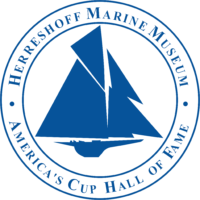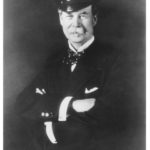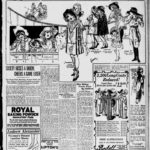July 1, 2015
The Curator’s Log: July 2015
Nathanael Greene Herreshoff and the America’s Cup: Part Fifteen- The 13th Challenge

Nathanael Greene Herreshoff and the America’s Cup:
Part Fifteen- The 13th Challenge
Negotiating the Challenge (1903- 13)
As noted in Part 14, the New York Yacht Club (NYYC), in successfully defending the Cup in 1903, had achieved its primary objective to beat Sir Thomas Lipton so decisively that he would go away and not challenge again for a long tme. Ten years would go by before Sir Thomas’ next challenge was accepted and a race scheduled.
That is not to say that Sir Thomas was silent on the subject. In Dec. 1902 the NYYC adopted Nat Herreshoff’’s Universal Rule for all of its race regattas. This rule included displacement as a factor to offset the driving force of sail area and waterline length that had resulted in extreme scows such as RELIANCE. In a Dec. 13, 1903 letter Sir Thomas inquired whether the new rules applied to the Cup. The NYYC refused to answer until in receipt of a regular challenge at which time the mutual agreement clause would govern all rules, provided that if no agreement then the challenger had the right to sail three races without time allowance with a boat measuring 65-90 ft. on the waterline.1
His next attempt with a conditional challenge in 1907 for a 1908 race was also rejected. Sir Thomas was consulting with SHAMROCK III designer William Fife who “positively refuses to design … under the old rules”,but was willing to design under the Universal Rule.Fife reiterated to Lipton, “it would be futile to attempt to ‘lift’ the cup with a freak boat which would have to be sailed across the Atlantic.” Sir Thomas agreed and authorized the Associated Press to report, “… he is ready to build a 90-footer under the new American Rule”.2
Ever popular, Sir Thomas received hundreds of telegrams, mostly from America, in support of his challenges. (And continued to sell a lot of tea; see his attached ad.) There were however mixed feelings in the yachting community. His supporters noted that he consistently raced in his home waters and was entitled to “consideration”. Others believed he had been given enough chances and a new foreign challenger would be best for the sport, but none appeared because of the “restrictions” they faced. P. K. Kemp enumerated these as follows:3
- Considerable expense of building and maintaining throughout the campaign
- Good chance that the challenger would be completely “out built” by the defender under the existing Seawanhaka Rule
- Challenger had to be strong enough to cross the Atlantic, while the defender could be lightly built to hang together for a season in home waters
- Following the Cup the challenger would be unable to race in home regattas because it was designed to compete under American measurement rules
The Herreshoff Manufacturing Company (HMCo) felt the impact of the hiatus in Cup races. Starting with the delivery of RELIANCE in late April 1903 there were layoffs that continued through the summer. While profits never again reached that of 1903, the order book remained healthy. The 1903 big steel schooner INGOMAR led to others that brought success and fame to Herreshoff on the European racing circuit, while the 1905 NY 30s and the 1912 NY 50s did the same in America.
In early 1913 Capt. Nat spent two months in Bermuda with his new ALERION. By the time he sailed for home on April 19th Cup fever was running high on both sides of the Atlantic and shortly after arriving in Bristol he received a postal telegram from George A. Cormack (NYYC Secretary), "Do not do anything about accepting order for Defender until you hear from me. G A Cormack”. This started a correspondence between the two about the challenge negotiations and the competing defender syndicates that continued through November; well after Herreshoff’s RESOLUTE was under contract in September.4
Sir Thomas had reopened negotiations in late Dec. 1912 with a definite challenge naming a boat of 75 ft. wl. and stipulating the NYYC meet him with a boat not over that length. NYYC answered by refusing to waive its right to meet with any size boat within the Deed. Sir Thomas withdrew the challenge.5 There are many news accounts available of the continuing negotiations but we can get the gist from two letters Cormack wrote to Capt. Nat:
- May 16, 1913- Marked "Confidential to NGH". Lipton has shifted his position again withdrawn offer with 75-footer. Insists on 90-footer.
- May 21, 1913- Lipton has withdrawn proposition for 90-footer before NYYC could reply. Much in papers but nothing official from Lipton. (Even this was not current because on the very same day Garrett, Secretary Royal Ulster Yacht Club, cabled Cormack their acceptance of the NYYC conditions.)6
Finally with the contractual maneuvering completed both sides of the Atlantic went off to build 75-footers to race the following September.
John Palmieri
1 Herbert L. Stone, The America’s Cup Races, T. Werner Laurie, LTD. London 1918. pp. 314-15. [British sources were researched because I believe they more accurately reflected the attitude and viewpoint of a potential challenger.]
2 Lipton’s New Offer: Outline of Sir Thomas’s Challenge May Be Sent To-day. New York Daily Tribune, Saturday Sept. 28, 1907. p. 4.
3 Lcdr. P.E. Kemp, RN, Racing for the America’s Cup. Hutchinson & Co. London, 1937. p. 218.
4 Telegram is undated. The Cormack/NGH correspondence is archived in the Herreshoff Marine Museum’s NGH Subject Folder; Resolute and Her Construction 1913-14. Access courtesy of Halsey C. Herreshoff .
5 Stone, p. 316.
6 Stone, p.320. (Even then the issue was not finally settled as Garrett in a July 19th cable to Cormack about boat lengths noted, “Lipton assumes…” This was met by a stern response by Cormack on July 31 noting that Lipton’s “assumes” has no bearing, as the agreement is as written by the two yacht clubs under the deed of gift. Garrett quickly backed down. Stone pp. 317-321.)


